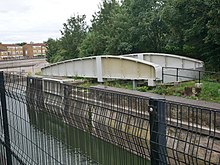Thamesmead
There is some evidence of prehistoric human occupation of the area: flints, animal bones and charcoal were found in bore holes around Western and Central Way in 1997 by the Museum of London Archaeological Service (MOLAS).
[1] In Roman times, the river level was significantly lower, and work by MOLAS in 1997 around Summerton Way revealed evidence of field ditches and pottery and quernstones from Germany dating from around the 3rd or 4th century.
[citation needed] Another radical idea of the GLC division architect Robert Rigg was taken from housing complexes in Sweden, where it was believed that lakes and canals reduced vandalism and other crime, mainly among the young.
[6] There is also an elevated 'escape route' from the estate to be used in the event of flooding, which runs along the top of a grassed mound to the north of Lesnes neighbourhood.
[7] The pre-1974 parts of Thamesmead are a mix of modernist town houses, medium-rise and 12-storey blocks system-built in concrete, which have featured in various films due to their 'rough urban look'; the design of the newer buildings is more traditional and in brick.
[6] When the GLC was abolished in 1986, its housing assets and the remaining undeveloped land were vested in a non-profit organisation, Thamesmead Town Limited (TTL).
The main reason cited for this decision was that many workers in Canary Wharf lived in Essex and could change from National Rail to the Jubilee line at Stratford and West Ham.
Thamesmead is also cut-off from the north of the River Thames and is in the centre of the 15-mile (24 km) gap between the Blackwall Tunnel and the Dartford Tunnel/QE2 Bridge.
Still, residential building continued, this time on the other side of the A2016, which cut this part of Thamesmead off from rail travel to central London.
The Tavy Bridge area is now being redeveloped by Gallions in partnership with Wates Group; the plans include homes with dwelling space at ground-floor level, making them susceptible to any future flooding.
Thamesmead now features a retail park finished in brick anchored around a Morrisons Supermarket; there is also a shopping parade which has mainly service-based outlets such as hairdressers and estate agents.
Some of the original overhead pedestrian walkways have been demolished for reasons of public safety and some ground-floor garages have been unfilled, as incidents of crime deterred their use as parking space.
[10] Thamesmead West contains Gallions Ecopark[11] a pioneering small social/affordable housing development with homes built to high energy efficiency and environmental standards.
The estate also includes a small lake and a number of man-made landmarks created from recycled excavated material that serve as viewing platforms.
Early 21st century new build properties in Thamesmead West have been blighted by social problems and mass repossessions,[14] attracting national attention.
In Thamesmead East, the River Thames makes its most northerly incursion within Greater London near the Crossness Sewage Treatment Works.
Nearby areas are: Barking & Dagenham (across the Thames), Belvedere, Abbey Wood, Plumstead, Charlton, Welling, Woolwich, Bexleyheath, Erith and Greenwich.
However, after the Fall of Saigon and the American withdrawal from Vietnam in the late 1970s, a small group of Vietnamese refugees built a community in the area.
[5] Thamesmead Moorings; Ethnicity Breakdown:[26] Black or Black British 42.9% White 42.4% Asian or Asian British 7.8% Mixed Race 5.3% Other Ethnic Groups 1.7% Some estate residents claim that gang T-Block (Now known locally as Greenside or GS28) have been left untouched by police, due to the high levels of drug-related crime and violence taking place in the Thamesmead area and local areas Abbey Wood and Plumstead.
[27] Gangs and crime have been prevalent in the area since the late 1970s due to increased rates of poverty, a failing economy and the rise of working class communities during The Tories' reign in government.
These groups (such as R.A.) felt inclined to defend their 'turf' and would often harass young black men and boys from Thamesmead, and surrounding local areas.
[30] Thamesmead's location between the Thames and the South London escarpment (see North Downs) makes it difficult to build new road and railway infrastructure.
[36] Thamesmead is also one of the starting points of the Green Chain Walk, which links to places such as Chislehurst and Crystal Palace.
Thamesmead is seen as a new and better alternative through the eyes of two small children who live in older, dilapidated flats in Nine Elms, Battersea.
The video of "Come to Daddy" by electronic musician Aphex Twin, directed by Chris Cunningham, was also shot in Thamesmead.
The music video for New York rapper A$AP Rocky's and London rapper Skepta's song "Praise the Lord (Da Shine)" was partially filmed at the Thamesmead Estate,[44][45][46] with the estate featuring prominently alongside shots of New York throughout the music video.





